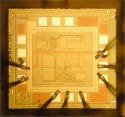Low-Power Neural Sensor Could Run Future Implantable Devices
November 9, 2009

sensor
A low-power neural amplifier collects electrical signals from nerves and minimizes electrical noise. (Photo: Brian Otis, University of Washington.)
Electrical engineers at the University of Washington (Seattle) have developed an implantable neural sensing chip that requires low power. Known as NeuralWISP, the new sensor platform draws power from a radio source situated up to a meter away. In contrast, some wireless medical devices such as cochlea and retinal implants rely on inductive coupling, requiring the power source to be centimeters away from the device.The device contains a microprocessor powered by a commercial radio-frequency reader that doubles as a data-collection device--the same equipment used to power and read information from radio-frequency identification (RFID) tags. The new technology could eventually find its way into sophisticated implantable medical devices.While neural implants have shrunk in size, most implantable devices still require multiple components that are larger than the transistors on the microcontroller, such as a clock for timing operations and an antenna for communication and power harvesting, remarks Brian Otis, professor of electrical engineering at the University of Washington and lead researcher on the NeuralWISP project.Placed on a circuit board slightly more than 2 cm long, the NeuralWISP is a collection of small low-power components such as a specialized signal amplifier. A future version will integrate all components onto a single 2-mm-long chip. The circuitry converts usable power from the roughly 430-µW reader to a voltage that can turn on the microcontroller. This microcontroller, in turn, controls the sensor and its timer and runs instructions that allow data to be sent back to the reader.One of the main ways to save power, says Otis, was to reduce how often the sensor measured electrical signals produced by neurons. The researchers programmed the microcontroller to wake up when an electrical spike occurred and record only the signals that were above a certain threshold.In addition to some circuit design considerations, researchers built a small signal amplifier that boosts the electrical signal from neurons while minimizing electrical noise. For this, they split the incoming signal into two parts. The amount of incoming electricity from neural activity is the same, but by splitting it between a pair of transistors within the circuit, the amount of noise is cut in half. 
moth
A tethered moth is connected to the neural sensing system, which records activity from its central nervous system as it flaps its wings. (Photo: Brian Otis, University of Washington.)
To sense central nervous system activity, the researchers devised experiments involving a moth, collecting data on electrical signals from the moth's wing muscles. The tests showed the frequency with which the moth flapped its wings. While the current system is too large to allow the moth to fly freely, an upcoming chip is small enough to enable unencumbered flight, Otis says."Most implantable devices have used lower frequencies," says Josh Smith, principal engineer at Intel and organizer of the WISP Summit, a workshop on wirelessly powered sensor networks and computational RFID held November 3 in Berkeley, CA. Lower frequency also means that the devices must be read at close range. Using commercial RFID readers allows the device to be powered and data to be read from further away, Smith adds.However, it is still an open question whether the antenna will maintain the long range once it is implanted in animal tissue because the signal might be absorbed. "Measuring moths is a good fit for this approach, since the antenna does not have to go inside the animal's tissue," Smith comments.Additional information on this technology is available in Technology Review, published by the Massachusetts Institute of Technology (Cambridge, MA).
You May Also Like


